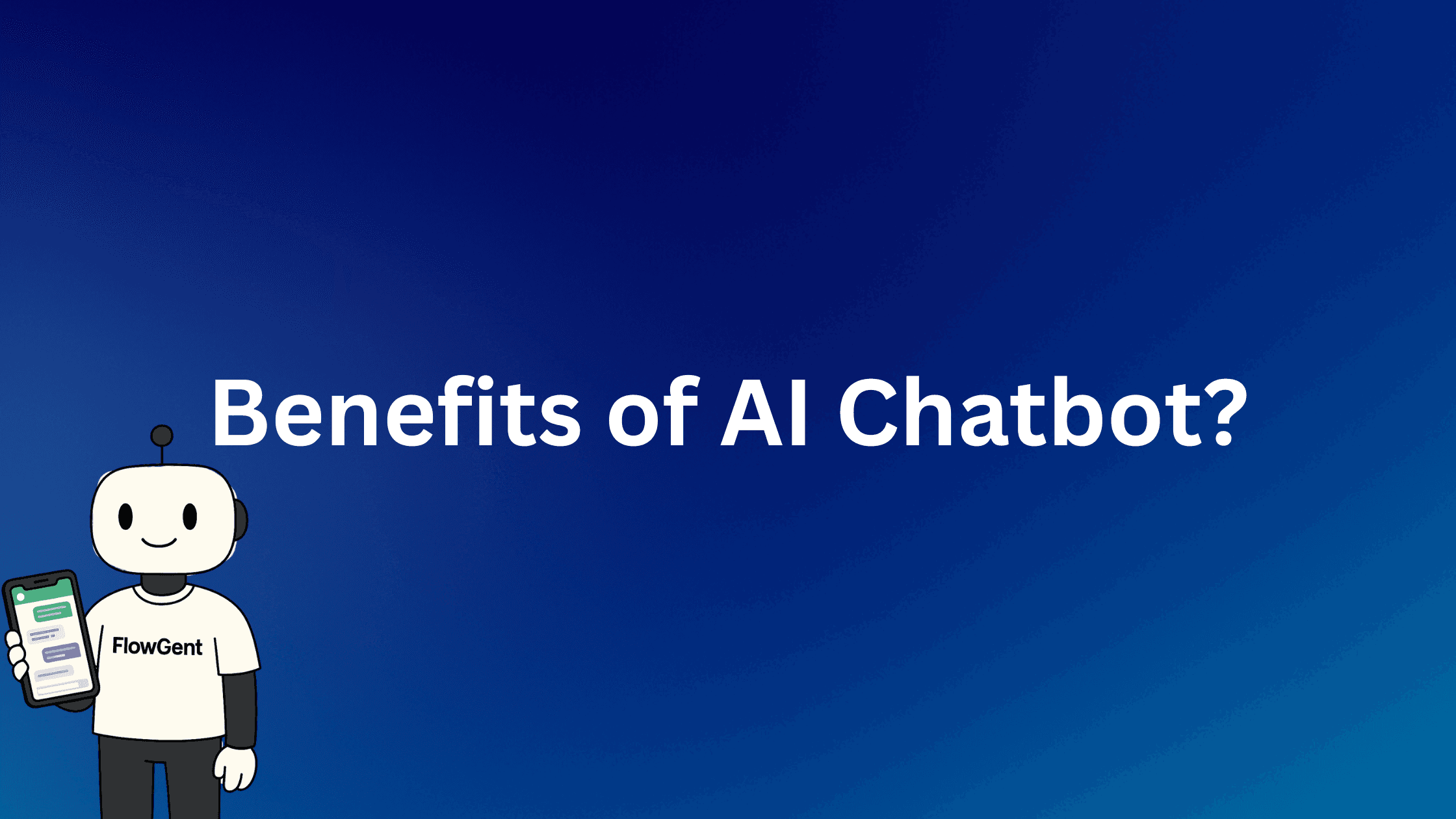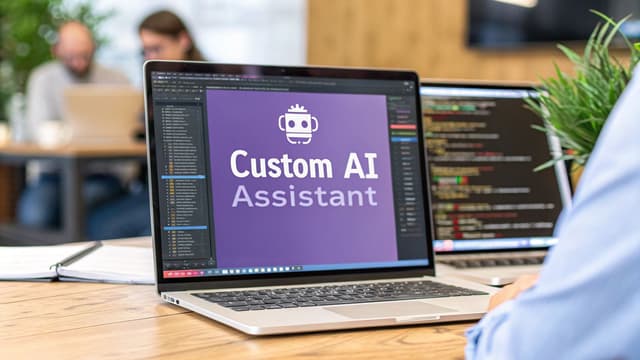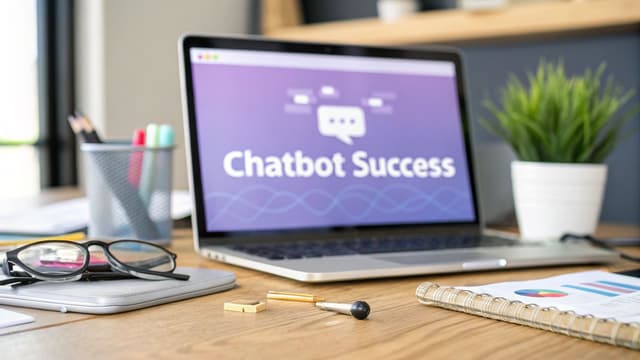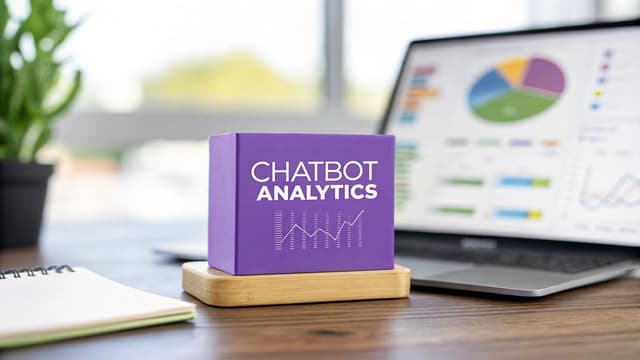When a boutique retailer plugged in an AI chatbot, response time dropped from 6 hours to 45 seconds and sales jumped 18 percent in 30 days.
This real result previews the wide-ranging benefits you will learn to unlock with AI chatbots in your own business.
The Real Benefits of Using AI Chatbots
Ever feel like you're playing customer service whack-a-mole? Just when you think you've handled one inquiry, three more pop up. Or maybe you're losing sleep wondering if that potential customer who messaged at 2 AM found what they needed, or if they've already moved on to your competitor.
You're not alone in this struggle. Small and medium business owners everywhere are discovering that traditional customer support just can't keep up with today's always-on expectations. But here's the thing: AI chatbots aren't just some fancy tech trend anymore. They've become a genuine game-changer for businesses that want to grow without burning out their teams.
Think of AI chatbots as your tireless digital teammates. They don't need coffee breaks, they don't call in sick, and they're genuinely excited to help your customers at any hour. But the real magic isn't just in their availability. It's in how they can transform your entire customer experience while actually making your life easier.
Whether you're running a bustling e-commerce store, managing client relationships at an agency, or trying to scale your service business, AI chatbots offer benefits that go way beyond just answering basic questions. They can qualify leads, handle bookings, process refunds, and even boost your sales by recommending the perfect products at just the right moment.
Ready to discover how these digital helpers can revolutionize your business operations and give you back your evenings? Let's dive into the real, practical benefits that make AI chatbots worth your attention.
Why AI Chatbots Are Booming in 2024
Let's be honest: 2024 feels like the year everything changed for customer service. Remember when waiting three days for an email response was considered normal? Those days are long gone, and your customers' expectations have shifted dramatically.
The numbers tell the story perfectly. Messaging apps like WhatsApp, Instagram DMs, and Facebook Messenger have become the new front door for customer interactions. Your customers aren't picking up the phone anymore. They're sending quick messages while they're on the go, expecting instant responses whether it's 9 AM or 9 PM.
This shift to on-demand service has created a perfect storm of opportunity and challenge. On one hand, you can connect with customers more directly than ever before. On the other hand, they expect you to be available 24/7, which is practically impossible for most small business owners who are already wearing ten different hats.
Enter the game-changer: advances in generative AI. What used to require months of programming and thousands of dollars can now be set up in minutes. These aren't the clunky, robotic chatbots of five years ago that could barely understand "hello." Today's AI chatbots can have natural conversations, understand context, and even handle complex tasks like processing orders or booking appointments.
The result? Businesses that embrace AI chatbots in 2024 aren't just keeping up with customer expectations. They're exceeding them while actually reducing their workload. It's like having a superpower that lets you be in multiple conversations at once, without the stress of juggling endless notifications.
The boom isn't just hype. It's businesses discovering they can finally scale their customer service without scaling their stress levels.
What Is an AI Chatbot and How Does It Work?
Think of an AI chatbot as your digital employee who never sleeps and always knows exactly what to say. But unlike the frustrating phone trees of the past, these modern marvels actually understand what your customers are asking for.
At its core, an AI chatbot uses something called natural language processing (NLP) to make sense of human conversation. When someone types "I need help with my order," the chatbot doesn't just match keywords. It actually understands the intent behind those words, recognizes the context, and responds appropriately. It's like having a team member who's fluent in customer-speak.
Here's where it gets interesting: these chatbots learn from training data and conversation patterns called "intents." Think of intents as different categories of things customers might want, like "check order status," "request refund," or "get product info." The more conversations the AI handles, the better it becomes at recognizing these patterns and providing helpful responses.
Now, you might be wondering if you need a computer science degree to set this up. Good news: you absolutely don't. The chatbot world has split into two camps. There are custom-coded bots that require developers and months of programming. Then there are no-code platforms that let you build powerful AI assistants using simple drag-and-drop interfaces, just like creating a presentation in PowerPoint.
The magic happens when these chatbots connect to your existing systems. They can pull information from your CRM, check inventory levels, process payments, and even schedule appointments. It's not just about answering questions anymore. These AI assistants can actually take action and solve problems in real-time.
The best part? Your customers can't tell they're talking to a bot until you want them to know.
12 Business and Customer Benefits of AI Chatbots
Ready to discover why smart businesses are racing to add AI chatbots to their toolkit? You're about to see exactly how these digital assistants can transform both your operations and your customer experience. Let's dive into the real benefits that matter most to your bottom line.
1. 24/7 Availability That Never Calls in Sick Your customers don't work 9-to-5 schedules, so why should your customer service? AI chatbots handle inquiries at 2 AM on Sunday just as effectively as they do on Tuesday afternoon. No more missed opportunities because someone reached out after hours.
2. Lightning-Fast Response Times While your competitors leave customers waiting, your chatbot responds instantly. We're talking milliseconds, not minutes. This speed creates an immediate positive impression that sets the tone for the entire interaction.
3. Massive Cost Savings in Support For an in-depth side-by-side pricing, see our Intercom chatbot pricing comparison. Here's the math that'll make you smile: one chatbot can handle the workload of multiple support agents, without salary, benefits, or vacation time. You'll see significant reductions in your customer service costs while actually improving service quality.
4. Effortlessly Scalable Conversations Black Friday traffic spike? Product launch buzz? Your chatbot doesn't break a sweat handling hundreds of simultaneous conversations. No more overwhelmed staff or frustrated customers stuck in long queues.
5. Smart Lead Generation and Qualification Your chatbot becomes your best salesperson, engaging visitors the moment they land on your site. It asks the right questions, captures contact information naturally, and qualifies leads before passing them to your sales team.
6. Personalization at Scale Every customer feels like your only customer. AI chatbots use purchase history, browsing behavior, and preferences to deliver tailored recommendations and responses that feel genuinely personal.
7. Measurable Revenue Uplift When customers get instant help with purchasing decisions, completion rates soar. Chatbots remove friction from the buying process, turning browsers into buyers more effectively than traditional methods.
8. Seamless Multilingual Support Expand globally without hiring multilingual staff. Modern AI chatbots communicate fluently in dozens of languages, opening your business to international markets overnight.
9. Valuable Data Collection and Insights Every conversation becomes market research. You'll discover what customers really want, common pain points, and opportunities for improvement, all while providing excellent service.
10. Consistent Brand Voice No more worrying about inconsistent messaging. Your chatbot delivers your brand's personality and values consistently, ensuring every customer interaction reinforces your company's image.
11. Employee Productivity Boost Free your team from repetitive questions so they can focus on complex problems and strategic work. Your staff becomes more satisfied and productive when they're not constantly interrupted by routine inquiries.
12. Omnichannel Experience Whether customers reach out via your website, WhatsApp, or social media, they get the same excellent experience. Your chatbot creates seamless interactions across all touchpoints.
The beauty of these benefits? They compound. Better customer experience leads to more referrals, reduced costs free up budget for growth, and improved efficiency lets you focus on what matters most: building your business.
Benefit Spotlight: Personalization at Scale
Here's where AI chatbots truly shine: they remember everything about your customers while treating each conversation like it's the first time they've met. Think about your favorite local coffee shop where the barista knows your order by heart. Now imagine scaling that personal touch to thousands of customers simultaneously.
The secret lies in how modern AI chatbots tap into your existing customer data. When Sarah visits your website for the third time this month, your chatbot doesn't just see another visitor. It recognizes her browsing history, knows she abandoned her cart last week, and remembers she's interested in sustainable products. The conversation becomes instantly relevant: "Hi Sarah! I noticed you were looking at our eco-friendly collection. Would you like to see our newest arrivals in sustainable fashion?"
This isn't just fancy technology showing off. It's behavior-based intelligence that drives real results. Your chatbot analyzes purchase patterns, seasonal preferences, and interaction history to make recommendations that actually resonate. Instead of generic "You might also like" suggestions, customers receive tailored advice that feels thoughtful and helpful.
The beauty of AI-powered personalization is its ability to learn and adapt in real-time. Each conversation teaches the system more about individual preferences and broader customer trends. Your chatbot becomes smarter with every interaction, building detailed profiles that would take human agents months to develop.
What makes this particularly powerful for growing businesses is the elimination of guesswork. You're not hoping your marketing message lands well, you're delivering precisely what each customer wants to hear, when they want to hear it. It's like having a personal shopping assistant for every single visitor to your business.
Ethical and Privacy Considerations You Cannot Ignore
Let's be honest: deploying AI chatbots isn't just about boosting efficiency and sales. You're handling real people's data, personal conversations, and trust. Get this wrong, and you could face hefty fines, damaged reputation, or worse. But here's the thing - ethical AI isn't just about avoiding trouble. It's about building genuine customer loyalty.
Transparency Builds Trust Your customers deserve to know they're talking to a bot, not a human. This isn't just good manners - it's often legally required. Start every chatbot conversation with a clear disclosure like "Hi! I'm an AI assistant here to help you." This honesty actually increases customer satisfaction because people appreciate knowing what to expect.
Data Minimization is Your Friend Just because you can collect data doesn't mean you should. Ask yourself: do you really need that phone number to answer a product question? The golden rule is simple: collect only what you need, use it only for its intended purpose, and delete it when you're done. This approach reduces your compliance burden and shows customers you respect their privacy.
Bias Detection Matters More Than You Think AI systems can accidentally inherit biases from their training data. Your chatbot might inadvertently treat certain customer groups differently, affecting everything from product recommendations to support quality. Regular testing with diverse user scenarios helps catch these issues before they impact real customers.
Your Compliance Checklist Whether it's GDPR in Europe, CCPA in California, or other regional regulations, privacy laws are getting stricter. You need clear consent mechanisms, easy opt-out options, and the ability to delete customer data upon request. Don't treat compliance as an afterthought - build these protections into your chatbot from day one.
The bottom line? Ethical AI chatbots aren't just legally safer - they're better business. When customers trust that you're handling their information responsibly, they're more likely to engage, share details, and become loyal advocates for your brand.
Ready to see FlowGent in action?
Start free in 10 min
Ensuring Privacy in AI Chatbot Usage
Now that we've covered the big picture of ethical AI, let's get practical about protecting your customers' privacy. Think of privacy protection like locking your front door: it should be automatic, thorough, and something you never have to worry about once it's set up properly.
Anonymize Personal Information Immediately The moment someone shares sensitive data like credit card numbers, social security digits, or home addresses, your chatbot should automatically mask or anonymize this information. Instead of storing "John's credit card ends in 4567," your system should record "Payment method verified for customer ID #12345." This way, you can still provide great service without keeping sensitive details lying around.
Choose Secure Communication Channels Not all messaging platforms are created equal when it comes to security. Look for channels that offer end-to-end encryption, secure data transmission, and compliance with industry standards. Your customers are trusting you with their personal information, so make sure your chatbot conversations happen through channels that take security seriously.
Build Privacy into Your Conversation Flow Design your chatbot to ask for the minimum information needed at each step. Instead of requesting a full profile upfront, gather details progressively as needed. When someone asks about shipping, that's when you ask for their address, not during the initial greeting. This approach feels more natural and reduces the amount of personal data floating around your system.
Regular Privacy Audits Keep You Safe Set up monthly reviews to check what data your chatbot is collecting, storing, and sharing. Delete old conversation logs that are no longer needed, and make sure your data retention policies match your actual practices. It's like cleaning out your email inbox, but way more important for your business reputation.
Frameworks for Measuring ROI of AI Chatbots
Here's the truth: if you can't measure your chatbot's return on investment, you're basically flying blind. But don't worry, measuring chatbot ROI isn't rocket science. You just need the right framework to track what matters and ignore the vanity metrics that look impressive but don't impact your bottom line.
Start with Your Cost Drivers First, calculate what you're actually spending. This includes your chatbot platform subscription, setup time (yes, your time has value), ongoing maintenance, and any integration costs. Don't forget the hidden costs like training your team or updating conversation flows. Once you know your true investment, you can measure meaningful returns against it.
Track Revenue Attribution Carefully This is where most businesses get it wrong. They either credit the chatbot with every sale it touches, or they don't track sales impact at all. The sweet spot? Use a weighted attribution model. If your chatbot qualifies a lead that converts three days later, give it partial credit. If it directly processes a purchase, that's full attribution. Track both assisted conversions and direct sales to get the complete picture.
Calculate Your Payback Period Here's a simple formula that works for any business: divide your total chatbot investment by your monthly net benefit (savings plus additional revenue). If you spent $3,000 setting up and your chatbot saves you $500 monthly while generating $300 in new sales, your payback period is 3.75 months. Anything under 12 months is typically considered excellent ROI.
Create Your ROI Dashboard Build a simple tracking system that monitors key metrics weekly: cost per conversation handled, conversion rates, customer satisfaction scores, and support ticket deflection. Most businesses find that a basic spreadsheet updated monthly gives them all the insights they need to optimize their chatbot performance.
The goal isn't perfect measurement, it's consistent tracking that helps you make better decisions about your AI investment.
Case Studies: AI Chatbot ROI in Action
Let's look at real numbers from real businesses. These aren't cherry-picked success stories or theoretical examples. They're actual results from companies that tracked their chatbot performance carefully and can show you exactly what happened to their bottom line.
Retail Success: 18% Sales Lift in 6 Months A mid-sized online clothing retailer implemented an AI chatbot to handle size questions and product recommendations. Within six months, they saw an 18% increase in conversion rates on pages where the chatbot was active. The bot answered questions like "Does this run large?" and "What goes well with this jacket?" instantly, preventing customers from leaving to research elsewhere. Their average order value also jumped 12% because the chatbot suggested complementary items based on browsing history.
SaaS Company: 40% Support Ticket Reduction A software company with 50,000 users deployed a chatbot to handle common technical questions and account issues. The result? They deflected 40% of incoming support tickets while maintaining customer satisfaction scores above 4.2 out of 5. This freed up their human support team to focus on complex problems and new feature requests. The company calculated they saved $180,000 annually in support costs alone.
Hotel Chain: 23% Booking Increase A boutique hotel group added chatbots to their booking process to answer questions about amenities, local attractions, and room availability. Direct bookings increased 23% year-over-year, and their average booking value grew by 15% as the bot successfully upsold guests to premium rooms and packages. The chatbot handled late-night inquiries when staff weren't available, capturing bookings that previously would have been lost.
The common thread? Each business focused on solving specific customer pain points rather than just automating conversations for the sake of it.
Common Integration Challenges and How to Solve Them
Getting an AI chatbot to play nicely with your existing business systems can feel like trying to connect a smartphone to a rotary phone. You know it should work, but the technical hurdles seem overwhelming. The good news? Most integration challenges follow predictable patterns, and once you know what to expect, they're much easier to solve.
The Legacy System Nightmare Your biggest headache will likely be connecting to older systems that weren't built with APIs in mind. Maybe your customer database runs on software from 2015, or your inventory system requires manual exports. Don't panic and don't assume you need to replace everything. Start by identifying which data your chatbot absolutely needs in real-time versus what can be updated daily or weekly. Often, a simple CSV export scheduled to run overnight can bridge the gap while you plan longer-term solutions.
Breaking Down Data Silos Here's what typically happens: your customer service team uses one platform, sales uses another, and marketing has their own dashboard. Your chatbot needs information from all three, but none of them talk to each other. The solution isn't always technical, it's often organizational. Map out who owns what data, then create a simple data-sharing agreement. Sometimes the easiest fix is giving your chatbot read-only access to each system separately rather than trying to merge everything into one source.
Managing the Human Side of Change Your biggest integration challenge might not be technical at all. It's getting your team comfortable with AI handling conversations they've always managed personally. Start small with low-stakes interactions like basic FAQ responses. Show your team how the chatbot escalates complex issues to them, rather than replacing them entirely. When people see AI as a helpful assistant rather than a threat, adoption becomes much smoother.
The key is tackling one integration at a time rather than trying to connect everything simultaneously.
Practical Solutions: Plugging AI Chatbots Into Your Stack
Here's where the rubber meets the road. You've decided you want a chatbot, but now you need to actually connect it to your existing tools without breaking everything. The good news is that most modern chatbot platforms give you three main connection methods, and you don't need to be a developer to pick the right one.
API Connections: The Gold Standard If your business software has an API (and most do these days), this is your best bet. APIs let your chatbot pull real-time information directly from your systems. Think of it like giving your chatbot a direct phone line to your customer database, inventory system, or booking calendar. The setup might take a few hours, but once it's done, your bot can check order status, schedule appointments, or pull customer history instantly. Most platforms provide step-by-step guides for popular integrations like Shopify, HubSpot, or Salesforce.
Webhooks: The Smart Middle Ground Webhooks work like automatic notifications between your systems. When something happens in your business (a new order, a support ticket, a booking), your system can ping the chatbot with that information. It's not quite real-time like APIs, but it's close enough for most situations and much easier to set up. Perfect for sending order confirmations or updating customers about appointment changes.
Native App Integrations: The Easy Button This is where platforms like WhatsApp, Slack, or your website come in. Instead of building complex connections, you're simply adding your chatbot to channels your customers already use. Most chatbot platforms offer one-click integrations with popular messaging apps and can embed directly into your website with just a snippet of code.
The secret is starting with one integration, testing it thoroughly, then gradually adding more connections as you see what works.
Frequently Asked Questions
What are the main benefits of using AI chatbots?
Key benefits include 24 7 support, faster response times, cost savings, personalized experiences and valuable data insights.
How do I calculate the ROI of an AI chatbot?
Compare support cost savings and revenue gains against total implementation and maintenance costs, then divide gains by costs.
Are AI chatbots secure and private?
Yes, when they use encryption, anonymize data and follow compliance frameworks like GDPR and CCPA.
What industries benefit most from AI chatbots?
Retail, healthcare, education, finance and hospitality gain significant efficiency and customer experience improvements.
What should I do before using an AI chatbot?
Define clear goals, collect FAQs, map user journeys and select a platform that integrates with your current tools.
Ready to Transform Your Customer Support?
FlowGent makes it incredibly easy to automate your customer support while maintaining the personal touch your customers love. With our no-code setup, you can be live in just 10 minutes.
Start your free trial today and see the difference FlowGent can make for your business.



